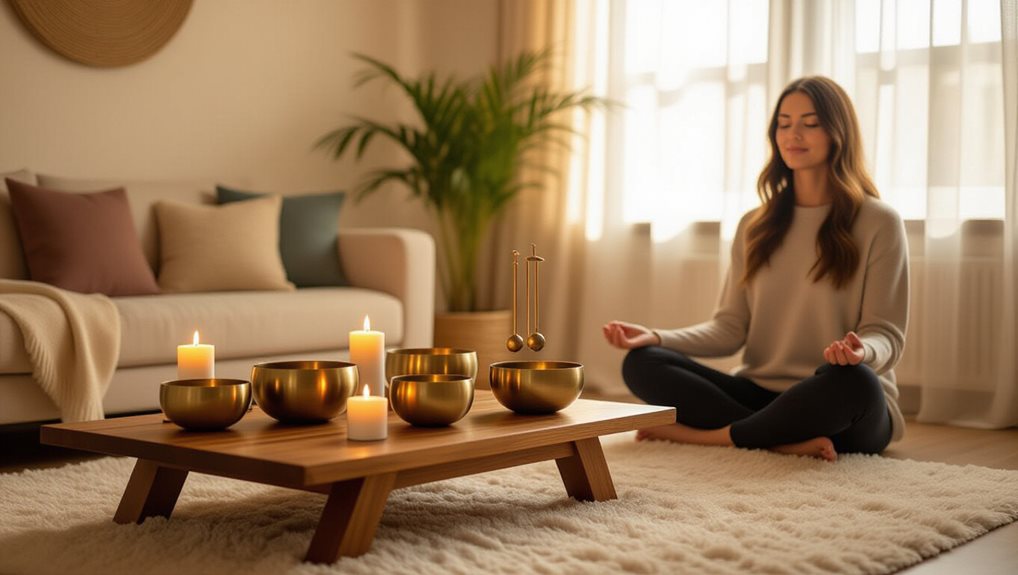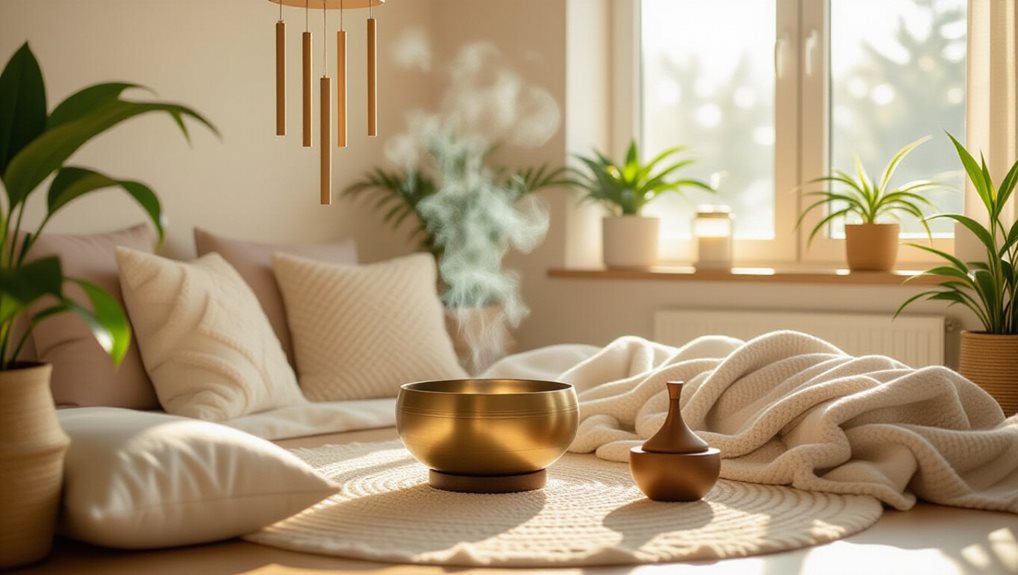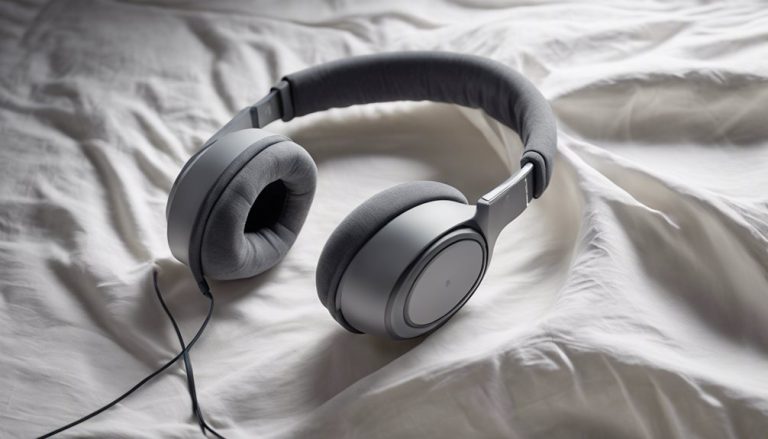Sound therapy can help ease your anxiety by targeting your brain’s emotional centers and promoting relaxation. Techniques like binaural beats and calming nature sounds synchronize your brainwaves to calmer states, supported by scientific research. Incorporating these sounds into your daily routine and creating a peaceful environment can enhance your mental clarity and emotional stability. If you want to uncover practical tools and tips, you’ll find many effective ways to calm your mind and nurture well-being.
How Sound Therapy Works to Reduce Anxiety

🎧 Try a Free Subliminal
No signup or login required — experience our Millionaire Mind Subliminal instantly.
Sound therapy works by directly influencing your brain’s emotional centers, helping to reduce feelings of anxiety. One effective way this happens is through brainwave entrainment, where specific sound frequencies synchronize your brainwaves to calmer states. Auditory stimulation, like calming tones or binaural beats, guides your brain into alpha or theta waves associated with relaxation and reduced stress. When you listen, your brain responds automatically, aligning its activity with the sounds you hear.
This process can help diminish anxiety symptoms by promoting a state of mental calmness. Scientific studies support this mechanism, showing that targeted auditory stimulation can positively affect mood and emotional regulation. Essentially, sound therapy gently guides your brain toward tranquility, making it a promising tool for anxiety relief.
The brain’s automatic adjustment to the difference between two tones played in each ear is a key aspect of how binaural beats achieve this effect through brainwave synchronization. Additionally, using binaural beats that induce alpha and theta waves can lower cortisol levels and heart rate, further enhancing relaxation and anxiety reduction.
Different Techniques in Sound Therapy
There are several techniques within sound therapy designed to help reduce anxiety, each leveraging different auditory methods to promote relaxation.
Binaural beats are a popular approach, where two slightly different frequencies are played in each ear, encouraging your brain to synchronize and enter a calm, meditative state. They are especially effective in reducing travel anxiety by calming the mind and nervous system.
Nature sounds, like flowing water or gentle wind, provide a soothing backdrop that can distract your mind from stress and foster a sense of peace.
These techniques work by engaging your auditory system in a way that activates relaxation responses in your body.
You might find combining binaural beats with nature sounds particularly effective, creating an immersive environment that helps calm racing thoughts and reduce anxiety naturally.
Using headphones enhances the experience by ensuring proper delivery of binaural beats frequencies for optimal brainwave synchronization.
Benefits of Incorporating Sound Therapy Into Daily Life

Incorporating sound therapy into your daily routine can greatly reduce stress and improve general well-being. Practicing mindful listening helps you stay present, allowing you to focus on calming sounds and tune out distractions. This intentional engagement with soothing audio promotes stress relief by calming your nervous system and reducing anxiety levels. Regular sound therapy sessions can trigger brainwave synchronization, enhancing the calming effects on your mind and body.
Regularly integrating sound therapy into your day encourages a sense of control and relaxation, supporting mental clarity and emotional stability. Over time, these practices can become a grounding habit that enhances your resilience to daily stressors. The routine nature of sound therapy makes it accessible and easy to sustain, empowering you to prioritize your mental health and create a peaceful environment for your mind to rest and rejuvenate. Sound therapy works by restoring the balance of your body’s natural vibrations through brain wave entrainment, which promotes relaxation and emotional balance.
Choosing the Right Sound Therapy Tools and Resources
How can you choose the most effective sound therapy tools and resources for your needs? Start by considering your personal preferences and the type of sound you find calming. Listening to fire crackling sounds is one example of a natural sound that many find soothing and effective for relaxation.
Sound selection is essential; it should resonate with you and promote relaxation. Investigate available resources like apps, online recordings, or dedicated devices, and assess their resource availability—are they easy to access and use regularly?
Look for evidence-based options backed by research, ensuring they genuinely support anxiety reduction. Reading reviews and trying out different tools can help you identify what works best.
Keep in mind, the right tools should fit seamlessly into your routine and feel comfortable. By focusing on sound selection and resource availability, you’ll set yourself up for a more effective and consistent sound therapy experience. Additionally, combining sound therapy with mindfulness techniques can enhance relaxation and stress management benefits.
Tips for Creating a Relaxing Sound Environment

Creating a relaxing sound environment begins with choosing sounds that truly soothe you and establishing a space free from distractions.
🎧 Start Your Audio Journey
Relax, recharge, and reprogram your mind with our Free Millionaire Mind Subliminal. No signup needed.
Ambient sounds, like gentle rain or soft wind, create a calming atmosphere that promotes relaxation. Nature noises, such as flowing water or birdsong, can also greatly reduce anxiety by grounding you in the present moment. Using binaural beats with specific frequencies can further enhance relaxation and reduce stress.
Gentle rain, soft wind, flowing water, and birdsong foster calmness and help ground you in the present.
To improve your environment, consider using high-quality speakers or headphones that deliver clear, consistent sound. Keep your space tidy and free of interruptions to maintain focus.
Experiment with different sounds until you find what resonates most with you. Consistency is key—regularly immersing yourself in these calming sounds helps retrain your brain to associate them with relaxation, fostering a sense of peace and reducing anxiety over time.
Using white noise soundscapes designed for deep relaxation can instantly improve your well-being and help calm the mind.
Common Questions
Can Sound Therapy Replace Traditional Anxiety Treatments?
You might find that sound therapy effectiveness varies, and while it can complement traditional treatments, it shouldn’t replace them. Comparing approaches, combining sound therapy with evidence-based methods often offers the best support for managing anxiety effectively.
How Long Does It Take to See Results From Sound Therapy?
You might notice improvements in anxiety symptoms within a few weeks, but sound therapy effectiveness varies with sound duration and consistency. Regular practice helps your brain adapt, gradually reducing anxiety and promoting relaxation over time.
Are There Any Risks or Side Effects Associated With Sound Therapy?
While sound therapy is generally safe, you should be aware of sound therapy precautions, since potential side effects like ear discomfort or headaches can occur. Always start with gentle sessions and consult a professional if you experience any adverse reactions.
Is Sound Therapy Suitable for Children or Pregnant Women?
You should consult healthcare providers before using sound therapy for children or expectant women. Children’s soundscapes and prenatal relaxation can be beneficial, but tailored guidance guarantees safety and effectiveness for their unique needs and sensitivities.
How Do I Customize Sound Therapy to My Personal Preferences?
You customize sound therapy by choosing sound selections that resonate with you personally, considering calming melodies or nature sounds, and adjusting volume and duration to create a soothing environment tailored to your preferences, enhancing your relaxation and anxiety relief.
Final Thoughts
While you investigate sound therapy, envision the soothing waves gently flowing over your mind, alleviating your concerns. With consistent practice, you might uncover a newfound peace hiding just beneath the noise. The right tools and environment can reveal a deeper sense of calm—but the true transformation happens when you take that initial step. Are you ready to listen to your inner calm and welcome the possibility of serenity waiting just beyond the next sound?




